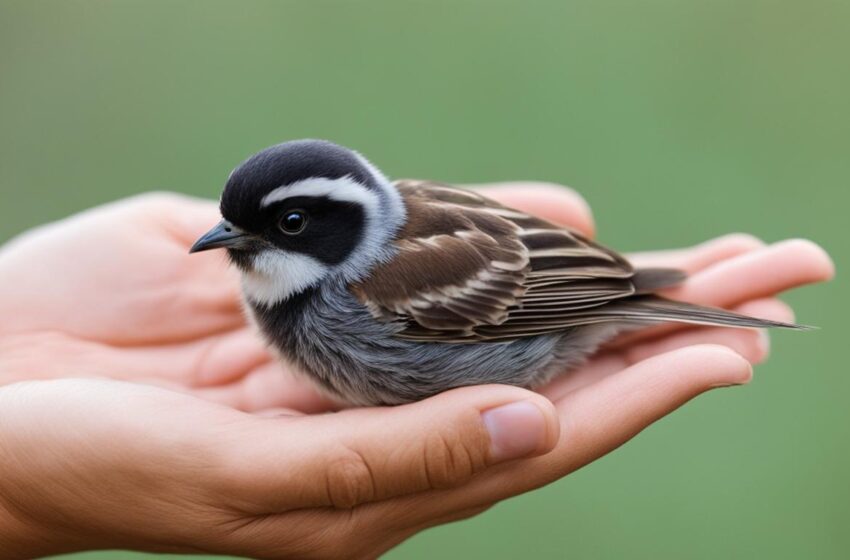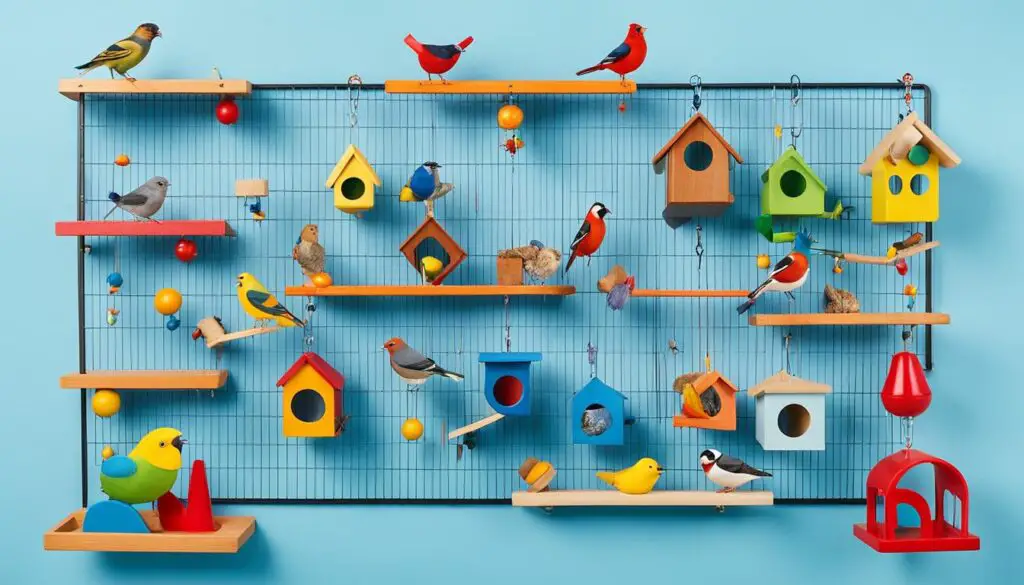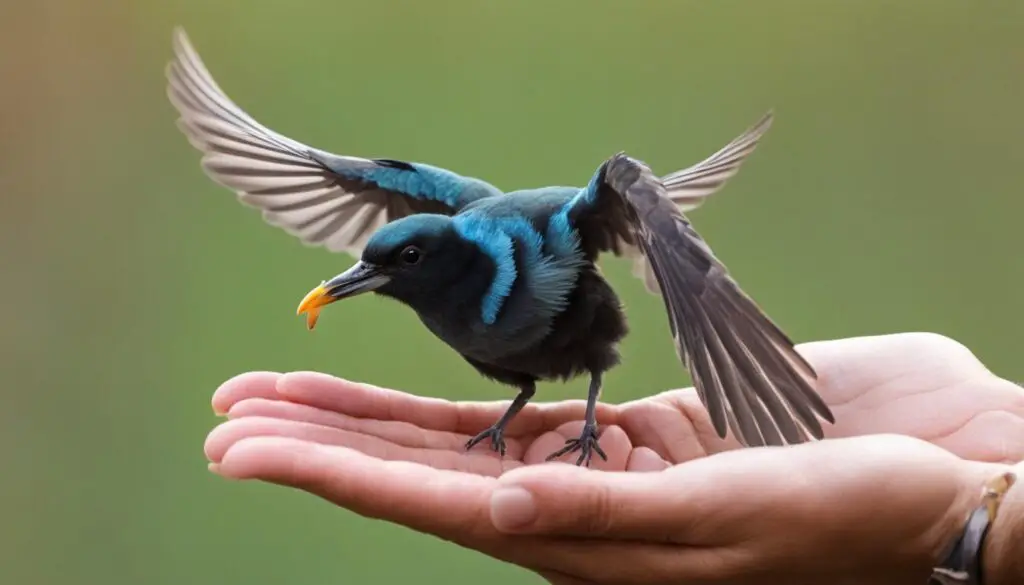Handling Small Birds Safely: Tips for Pet Owners

Owning a small bird as a pet can be a joyful and rewarding experience. These tiny creatures bring life and beauty to our homes, filling them with their delightful chirping and colorful feathers. However, it’s crucial to handle these delicate birds with the utmost care, ensuring their safety and well-being.
Pet bird safety should always remain a top priority for bird owners. By understanding the proper techniques and creating a safe environment for handling, you can build a strong bond with your feathered friend while keeping them secure.
Key Takeaways:
- Handle small birds gently and patiently, avoiding grabbing or squeezing.
- Recognize and respect your bird’s body language and signals.
- Create a safe and comfortable handling environment, free from potential hazards.
- Invest time in bonding and socialization activities to strengthen trust and companionship.
- Consult a qualified avian veterinarian to learn proper handling techniques for specific situations.
Understanding Small Bird Behavior and Body Language
Before attempting to handle your small bird, it’s crucial to understand their behavior and body language. Birds communicate through various signals, such as fluffing their feathers, chirping, and body postures. By observing these cues, you can determine if your bird is comfortable, scared, or agitated. It’s essential to respect your bird’s boundaries and not force interaction if they seem anxious or fearful.
Small birds have unique behaviors and body language that can provide valuable insights into their mood and well-being. Here are some key bird signals to look out for:
- Fluffed feathers: When a bird fluffs its feathers, it indicates relaxation and contentment. It’s a sign that your bird feels safe and comfortable in its environment.
- Chirping: Birds use chirping to communicate various messages. Cheerful and melodic chirping typically indicates a happy and content bird. However, excessive or repetitive chirping might suggest stress or discomfort.
- Body postures: Pay attention to how your bird positions its body. A bird that stands tall, with its feathers sleeked down, and its eyes bright is typically alert and attentive. On the other hand, crouching low, ruffled feathers, and dilated pupils may indicate fear or discomfort.
By reading and interpreting these bird signals, you can gauge your small bird’s emotional state and adjust your approach accordingly. Understanding their body language will allow you to create a safe and trusting environment for both you and your feathered friend.
Remember, small birds are delicate creatures, and their behavior and body language should be respected. Forcing interaction or handling them when they are anxious or scared can lead to stress, injury, and even negative associations with human contact.
Creating a Safe Handling Environment for Your Bird
Providing a safe environment for handling your small bird is crucial for their well-being and your peace of mind. By creating a bird-friendly space, you can ensure safe bird interactions and enjoyable handling sessions. Here are some important considerations to keep in mind:
1. Clear the Area of Potential Hazards
Before handling your bird, ensure that the room or space is free from any potential dangers. This includes removing any open windows or doors, as birds can be easily startled and may attempt to fly out. Additionally, other pets should be kept out of the room to prevent any unwanted interactions that may cause stress or harm to your feathered friend.
2. Provide a Comfortable Perching Area
Birds love to perch and feel secure in their environment. A designated bird stand or branch-like perch can offer a safe and comfortable spot for your bird to rest and interact with you. Be sure to choose a perch that is appropriate for the size of your bird, ensuring stability and a comfortable grip.

3. Engage in Enrichment Activities
Keeping your bird mentally stimulated is important for their overall well-being. Offering a variety of toys and enrichment activities can help keep them engaged and prevent boredom during handling sessions. Choosing toys that encourage natural behaviors, such as foraging or climbing, can provide both physical and mental stimulation for your bird.
“Toys and enrichment activities are not only fun for your bird, but they also help mimic their natural environment and promote overall health and happiness.” – Dr. Jane Peterson, Avian Behavior Specialist
4. Supervise and Monitor Interactions
Always supervise your bird during handling sessions and pay close attention to their body language. Birds communicate through subtle cues, and it’s important to respect their boundaries and comfort levels. If your bird shows signs of anxiousness or distress, it’s best to give them space and try again later when they are more relaxed.
5. Maintain a Clean Environment
A clean and hygienic environment is essential for the health of both you and your bird. Regularly clean and sanitize perches, toys, and handling areas to prevent the buildup of bacteria or other harmful pathogens. Consult your avian veterinarian for specific cleaning recommendations and guidelines.
| Importance of a Safe Bird Handling Environment | Benefits |
|---|---|
| Minimizes the risk of accidents or injuries during handling sessions | – Provides a stress-free environment for your bird |
| Ensures a positive and enjoyable bonding experience | – Promotes trust and strengthens the bond between you and your bird |
| Supports the overall health and well-being of your bird | – Reduces the likelihood of stress-related health issues |
Creating a safe handling environment for your bird helps foster a positive and trusting relationship. By following these guidelines, you can provide a secure and enriching atmosphere for your beloved feathered companion.
Proper Techniques for Handling Small Birds
When it comes to handling small birds, using gentle and patient techniques is essential. This ensures the well-being and comfort of your feathered friend. One common method used by bird owners is bird step-up training, which allows the bird to voluntarily step onto your finger or a perch. By offering a stable and secure platform, you can build trust and develop a positive relationship with your bird.
During step-up training, remember to approach the bird slowly and avoid sudden movements. Here are some steps to follow:
- Position your hand or a sturdy perch near the bird and allow them to observe before attempting to step onto it.
- Use a calm and soothing voice to encourage the bird to approach your hand or perch.
- Once the bird is comfortable, gently present your finger or the perch at the same level as their chest. This allows them to easily step onto it.
- Reinforce positive behavior by offering praise or a small treat.
It’s important to avoid grabbing or squeezing the bird, as this can cause injury or distress. Always respect the bird’s boundaries and be patient if they are hesitant. Consistency and positive reinforcement are key to successful step-up training.
In situations where you need to restrain your bird, such as for grooming or veterinary care, it’s crucial to use proper techniques. Seek guidance from a qualified avian veterinarian who can teach you safe and effective methods for restraining your bird without causing harm. This ensures the well-being and safety of both you and your feathered companion.
Remember, a gentle touch and understanding of your bird’s needs are paramount when it comes to handling small birds.

| Do’s | Don’ts |
|---|---|
| Use gentle and patient techniques | Avoid grabbing or squeezing the bird |
| Practice step-up training for voluntary interactions | Force the bird to interact if they are anxious or fearful |
| Seek guidance from a qualified avian veterinarian for restraint techniques | Use excessive force when restraining the bird |
Providing Bonding and Socialization Opportunities
Bonding and socialization are crucial factors in cultivating a strong and fulfilling relationship with your small bird. By dedicating quality time to interact with your feathered friend in a calm and positive manner, you can establish a deep sense of trust and companionship.
During your bonding sessions, offer tasty treats to your bird as a gesture of affection and reward. This not only demonstrates your love, but also encourages positive associations with your presence. Engaging in gentle play activities, such as tossing small toys or engaging in interactive games, can further deepen the bond between you and your bird.
When communicating with your bird, use soft and soothing voices. Birds are highly receptive to tone and inflection, and a gentle, melodic voice can help create a soothing and nurturing atmosphere. By attentively observing your bird’s body language, you can better understand their comfort level and respect their boundaries.
Remember, trust-building activities take time and patience. Gradually introduce handling and physical contact, allowing your bird to become accustomed to your touch at their own pace. With consistent reassurance and understanding, your bird will develop a strong bond with you, making them more comfortable with handling and eager to enjoy your companionship.
FAQ
How can I understand my small bird’s behavior and body language?
By observing signals such as fluffed feathers, chirping, and body postures, you can determine if your bird is comfortable, scared, or agitated.
What precautions should I take when creating a safe handling environment for my bird?
Make sure the area is free from hazards, such as open windows and other pets. Provide a comfortable perch and engage your bird with toys and enrichment activities.
How should I handle my small bird without causing harm?
Use gentle and patient techniques, such as step-up training where you offer your finger or a perch for the bird to step onto. Avoid grabbing or squeezing the bird.
Are there any tips for bonding and socializing with my small bird?
Spend quality time with your bird in a calm and positive manner. Offer treats, engage in gentle play, and use soft, soothing voices to build trust.
Source Links
- https://www.conchovalleyhomepage.com/crime/jail-logs/tom-green-county-jail-logs-january-7-2024/
- https://www.theguardian.com/books/2024/jan/08/the-ultimate-summer-reading-list-15-thrillers-and-mysteries-to-keep-you-guessing
- https://summitpainspecialist.com/web-stories/10-of-the-best-kinds-of-pets-for-people-who-want-something-to-love/



